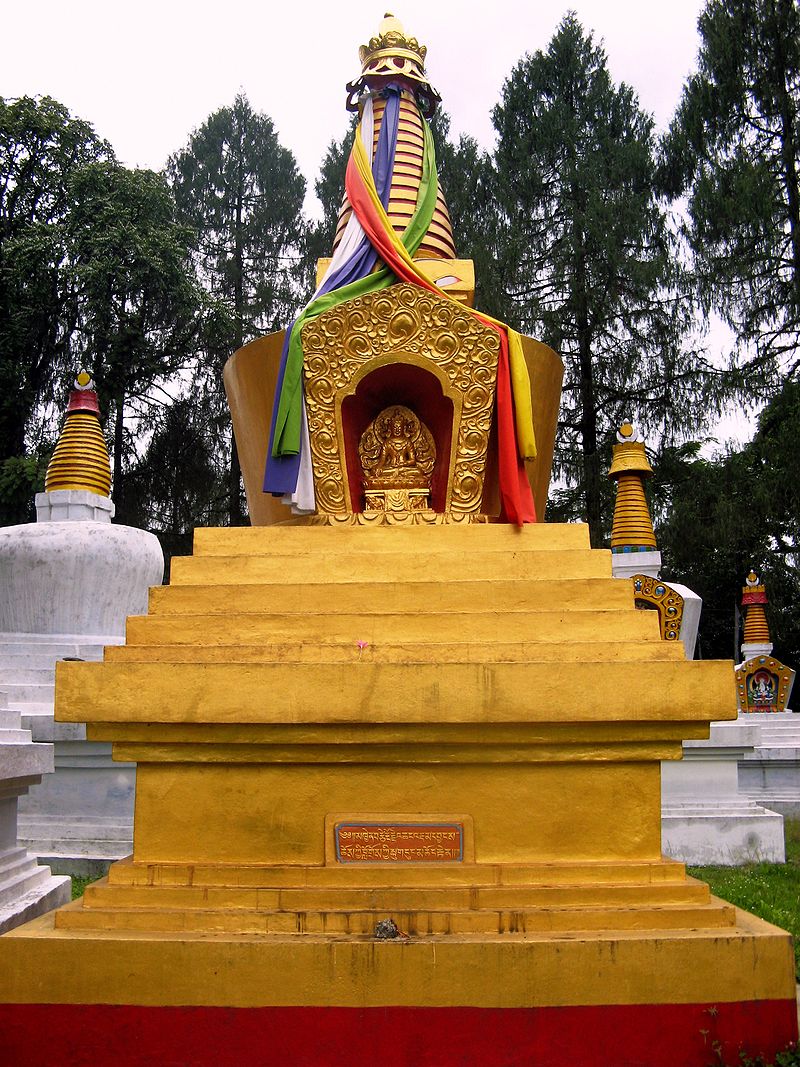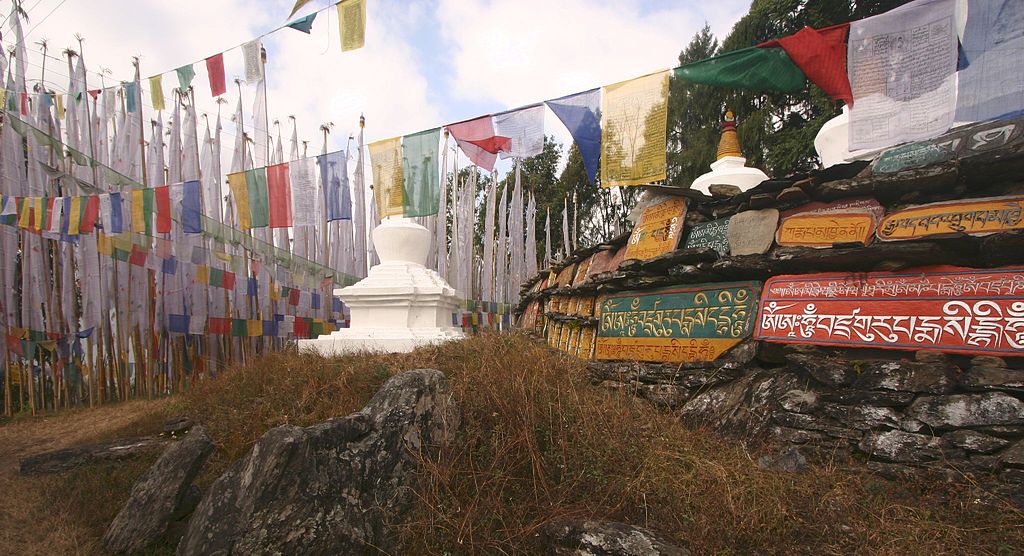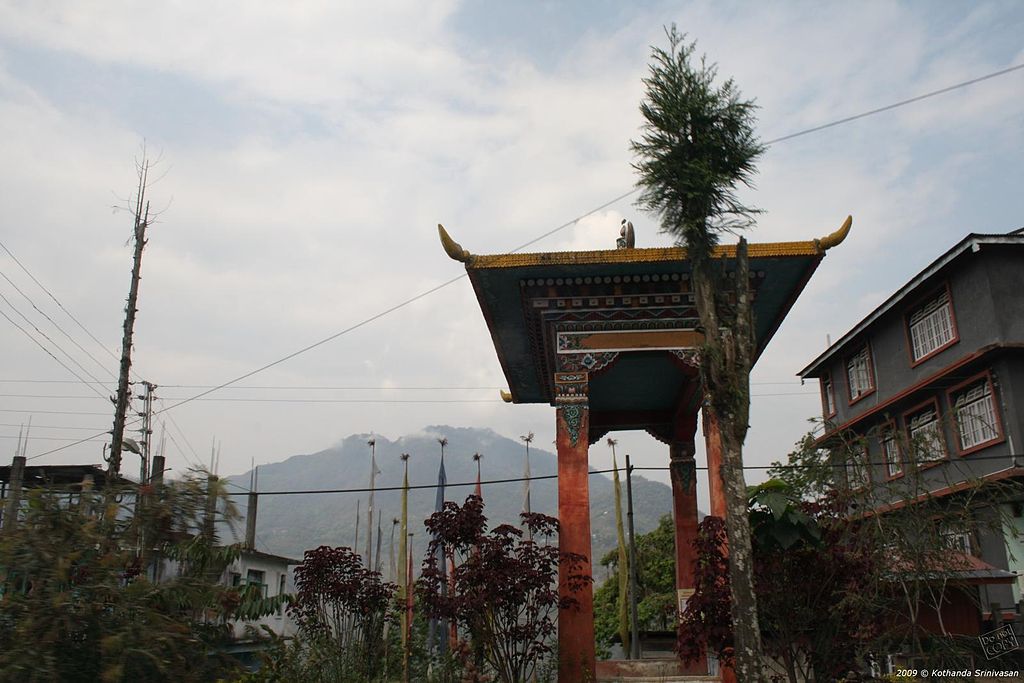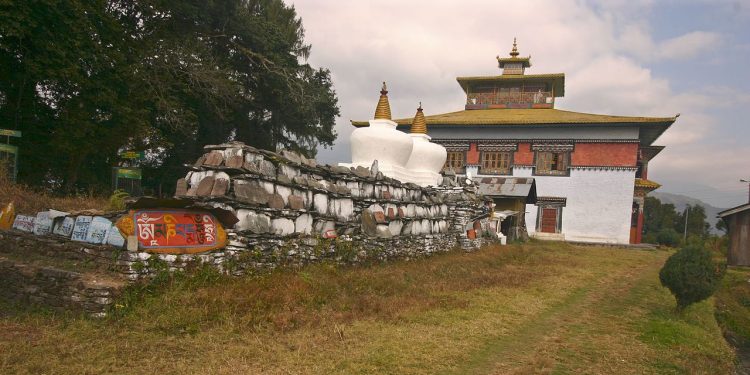Located 40 km from Geyzing in the west of Sikkim, Tashiding Monastery is one of the oldest and holiest Buddhist temples in Sikkim. It was built in the year 1717 and is beautifully nestled on the top of a hill between Ranjit and Rathong Rivers.The Monastery which has a stunning view of Mount Kanchenjunga houses Manis or stone plates carved with sacred Buddhist mantras.
Shrine’s History
In the 17th century, Ngadak Sempa Chemp built a small Lhakhang at this location. This was enlarged into the present monastery during the reign of Chogyal Chakdor Namgyal. Pedi Wangmo built the main monastery and installed many statues which are still seen in the monastery. Lhatsun Chenpo built the Chortens; which are considered holy. Yanchong Lodil, the Master Craftsman crafted the flagstones that surround the monastery. These are carved with the holy Buddhist mantra ‘Om Mane Padme Hum’.

Legends Associated with This Shrine
There are several legends linked to the most revered monastery and the Bhumchu festival that is held here. According to one local legend, Guru Padmasambhava shot an arrow into the air to select the place. Where the arrow he shot landed, he sat in meditation and that site eventually became the site of the Tashiding Monastery.
Another legend relates to the three monks who consecrated the first Chogyal of Sikkim at Yuksam. It is said that the three monks saw an unusual divine phenomenon of bright light shining on top of the Kanchendzonga mountain, which reflected to a site near the place where the present Tashiding Monastery has been built. Concurrently, a scented smell of incense followed by all pervading divine music was also noted. The first Chogyal who visited the site subsequent to hearing this unusual event, erected a small chorten at the site and named it as Thongwa-Rang-Grol. Legend further glorifies the site stating that a mere sight of it confers self-emancipation?. Another absorbing legend is related to the celebration of the Bhumchu festival at Tashiding Monastery.
The legend is traced to the tantric art. Guru Padmasambhava, while teaching the tantric system of Mahakarunika Avalokiteshvara Sadhana and initiation on emancipation from the cycle of mundane existence? to the King Trisong Duetsen, prince Murub Tsenpo, Yeshe Tsogyal and Verotsana in Tibet, sanctified the same holy vase with holy water, which is now kept in Tashiding Monastery and revered during the Bhumchu festival. This vase is made of five types prized jewels, divine soil and holy water said to have been gathered by Padmasambhava from religious centres in India, Odiuana and Zahor. The vase was made by the wrathful deity Damchen Gar-bgag and sanctified by Guru Padmasambhava himself by performing the Sadhana of Yidam Chuchig Zhal ?. On this occasion, heavenly deities appeared in the sky and thereafter merged into the holy water contained in the vase. The vase then overflowed and the water dispersed in all directions in the form of rays.? This ritual was immediately followed by an earthquake, which was considered an auspicious sign.
The divine moment also witnessed the presence of the four guardian divinities namely, the Gyalchen Dezhi/Cutur ? Maharajika of Dharma and the gods of the thirty-three heavens who showered flowers from the sky.? The event was witnessed by devotees and Padmasmabhava distributed the holy water from the vase to all assembled people, which spiritually benefited one and all. The vase was then hidden as a treasure under the care of the divine deities. However, the vase was rediscovered and passed through the hands of several holy men and finally placed at Tashiding by Terton Ngdag Sampachenpo. During the reign of the first ruler of Sikkim, Phuntshog Namgyal, the Terton recited the holy hymn Om Mani Padme Hum? five billions when several unique events were also witnessed in Sikkim. After the religious ceremony the vase with the water has been kept on display in a small chamber in the Monastery under the custody of the Chogyal himself, which is opened once a year during the Bhumchu festival

Architectural Relevance of This Shrine
An overall picture of the precincts of the monastery within the Tashiding town is provided in five distinct blocks namely, the Sinem marketplace, the outskirts, the main market place, the main Tashiding Monastery and the Chorten area. The Sinek marketplace is located on an incline on the ridge between Rathong Chu and Rangeet River. There is a gompa here called the Sinolochu Gompa from where an approach leads to the Tashiding Monastery in the southern direction. The settlement is spread lengthwise and is 23 kilometres from Yuksom. A large ‘Mani’ stone is seen at the entrance to this settlement and the Tashiding market. From the main market centre, the approach to the Monastery is through a road, and also a footpath. The footpath in the southern direction has a gentle slope and passes through a Mani and then prayer wind wheels terminating at the entrance gate of the Monastery. The Monastery itself consists of a ‘Mani Lhakang’ at the entrance surrounded by flags, and lead to the guest house.
From this point ahead is the main ‘Tashiding Gompa’ which is called as Chogyal Lhakhang or the monastery, followed by the ‘butter lamp house’, four chortens, ‘Tsenkhang’, a new butter lamp house and finally terminating at the ‘Guru Lhakhang’, which is the temple of Guru Rinpoche. Other basic essential structures such as kitchen, school and residential housing are located on the left side of the approach path to the monastery. Chorten and inscription slabs outside the Tashiding Monastery. In the ‘Chorten area’, there are 41 chortens categorised as ‘Chotens of Enlightenment’, ‘Chortens of Reconciliation’ and ‘Chortens of Great Miracle’, which are all of Rinpoches and Tathāgatas. However, the main temple has undergone renovation work in modern times and rebuilt, but is still encircled by traditional buildings and chortens at the far end of the site, which holds the relics of Sikkim Chogyals and Lamas, including the ‘Thong-Wa-rang-Dol’ chorten which is believed to cleanse the soul of any person who looks at it. Also of major note are the stone plates called the ‘Mani’, the work of Yanchong Lodil who inscribed them with the sacred Buddhist inscriptions, such as “Om Mane Padme Hum”

Shrine’s Map Location and How to Go There
By Road
Gangtok, the capital of Sikkim is connected via roads to Darjeeling, Kalimpong, Siliguri and also to all the District headquarters within Sikkim. The Monastery is 40 km from Pelling 15 km from Legship and 20 km from Yuksam.
By Rail
The Two nearest railway station are at Siliguri (114 km) and New Jalpaiguri (125 km)
By Air
The Nearest airport is Bagdogra in West Bengal (124 km).






































